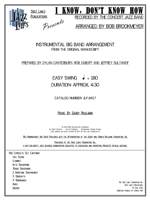I KNOW, DON'T KNOW HOW [DOWNLOAD]
Recorded by the Gerry Mulligan Concert Jazz Band
Arranged by Bob Brookmeyer, Prepared by Dylan Canterbury, Rob DuBoff, and Jeffrey Sultanof

Cat #: JLP-8417DL
$65.00This product is available for immediate download after purchase.
Questions?
Please call +1-518-587-1102 or email us.
Edition: Jazz Big Band Arrangement
Description: Swing - Medium Difficult
Publisher: Jazz Lines Publications
Initially written for and recorded by his sextet, Gerry Mulligan's "I Know, Don't Know How" was expanded for his Concert Jazz Band by valve trombonist/arranger Bob Brookmeyer for his 1961 album "Gerry Mulligan Presents a Concert in Jazz." This arrangement manages to maintain the trademark sound of Mulligan's small groups while adding several layers of Brookmeyer's trademark complexity to create a structural masterpiece of a chart.
As is typical for Mulligan's ensembles of this time, the volume level remains largely subdued throughout the entire chart. Even the intro, which is otherwise fairly boisterous, should ascend to at most a medium-loud level. Mulligan enters with the melody pickups into measure 9. At first, the ensemble lines up with one another for the accompanying backgrounds, but beginning at measure 17 Brookmeyer ramps up the complexity a bit by having the woodwinds and trombones playing counter lines to one another; even individual members of the section occasionally drop out or switch sides at times. These interweaving lines, both here and through the rest of the arrangement, need to be aware of one another in order to not step on each others' toes, so to speak.
Mulligan takes a quick break from the melody at measure 25 to allow the unison trumpets a chance to shine over the somewhat baroque-sounding woodwind and trombone backgrounds. Returning at the pickups to measure 33, Mulligan takes the spotlight for himself for a sizeable chunk of the rest of the arrangement, playing an improvised solo following an ensemble tag from measure 45 to 102. The backgrounds behind his solo are simplistic and subdued, and should be approached accordingly.
A half chorus of ensemble begins at measure 103, still at a subdued volume, that leads into a chorus and a half of Brookmeyer's valve trombone beginning at measure 111. The first half chorus is devoid of backgrounds, while the first two A sections of the 2nd chorus at measure 129 feature a series of horn stings that should be one of the more aggressive sections of the arrangement. Measure 139 sees a background counter line from Mulligan, clearly intended as a call-back to Mulligan and Brookmeyer's small group work together.
The ensemble interlude at measure 155 is one of the most complex portions of the arrangement, featuring several interlocking triplet lines passed around throughout the ensemble. Be sure to emphasize the multiple dynamic swells throughout this section. Measure 163 is yet another call-back to the Mulligan piano-less quartet, with Mulligan and Brookmeyer soloing together and creating some classic improvised counterpoint for a full chorus.
Mulligan returns to the melody at measure 195, this time with some significantly more complicated backgrounds than before. The ensemble reaches its peak volume (indeed, the only part of this arrangement that can be considered loud) on the bridge at measure 204, with several smears and triplet figures adding to the drama. The final A section at measure 212 is largely copied from earlier in the arrangement. The tagged riff from earlier is repeated as the volume level decays even more, with a few rapid dynamic shifts eventually leading into the final two chords. The first is fairly dissonant, but the second is as warm as can get. Mulligan plays a simple cadenza over each to bring things to a lovely conclusion.
This arrangement is written for jazz big band. It is not a transcription - it has been prepared from the set of original parts used during the recording session. On the original recording, there is a cut from measure 75 to 128, likely for time purposes. The entire arrangement has been presented in its original form in order to preserve how it was originally envisioned.
Clarinet
Alto Saxophone
Tenor Saxophone
2 Baritone Saxophones
3 Trumpets
3 Trombones
Bass
Drums
Trombone 1: Ab4












